Transport Dumpster in Exchange 2007 (Part 2)
In the second and final part of this article, we will take a closer look at Transport Dumpster in Exchange Server 2007. In part 1, we learned what transport dumpsters are, how to configure and assign them. its face.
>> Transport Dumpster in Exchange 2007 (Part 1)
Next we will learn more about how to resize the Transport Dumpster and how to control it on the system.
Capacity of Transport Dumpster
The capacity of the Transport Dumpster affects the design of the Hub Transport server because you will have to consider the size of the mail queue in the Transport Dumpster as well as the additional I / O (Input / Output) disks that will be displayed when the Transport Dumpster is activated.
Admittedly, the current disk capacity of a transport dumpster is not necessarily large if the Hub Transport server is not used for a large number of storage groups. Remember that the capacity of the transport dumpster is configured on a Per-Storage Group Basis. First we will test a system of two Hub Transport servers used for a separate CCR system containing 10 Group Storage. If the maximum mail capacity in the system is 30MB, we must set the value for the MaxDumpsterSizePerStorageGroup parameter to 45MB . Therefore the free space on the drive to use is 450MB (45MB * 10). Normally you will want to occupy this disk space on each Hub Transport server because you want to make sure that the entire system is still functioning properly in case one of the Hub Transport servers is down.
As another example, we have a system consisting of two Hub Transport servers, and both servers are used for three CCR systems, each containing 15 Storage Groups with a maximum mail size of 50MB. In this case the MaxDumpsterSizePerStorageGroup parameter should be set to 75MB (50MB * 1.5). Since there are a total of 45 Storage Groups you will need to prepare about 3.4GB (45 * 75MB) of disk space for the Transport Dumpster .
Remember that the transport dumpster disk space requirements related to the disk storage file of the Hub Transport server mail.que because the transport dumpster is stored in this database. Because the Hub Transport database is an ESE database (Extensible Storage Engine), the mail.que file is often moved to a dedicated drive for performance reasons.
The effects on the I / O disk are caused by activating the Transport Dumpster feature, since activating the Transport Dumpster will increase the I / O disk space so you should consider this.
Transport Dumpster Management
In a CCR system, the Get-StorageGroupCopyStatus command can be used to store information across the feedback system. There is an extra parameter that is not used by default that can be used to display information on the Transport Dumpster statistics. This parameter is DumpsterStatistics . For example, Figure 7 shows the Get-StorageGroupCopyStatus command running with the format-list command and additionally filtered to display all parameters contained in the dumpster string. In Figure 7, the parameters are repeated twice because there is no Storage Group on this particular CCR system.

From Figure 7 you can also see that no dumpster statistics are displayed. To test these statistics, you need to use the DumpsterStatistics parameter as shown in the following command:

Next we will check the statistical information on a busy server. In Figure 9 you can see that the information displayed for a single Storage Group has been retrieved and the Transport Dumpster for the Hub Transport SRV1 server now contains 1030 items with a total capacity of 819KB. You will also see the date and time of the oldest mail in the Transport Dumpster queue.

To check for more detailed information on Transport Dumpster statistics, we can use the execution management program. On the Hub Transport server, an executable object named MSExchangeTransport Dumpster can be found to contain 5 counters (storage devices that show events or processes that have occurred). You can see these counter in Figure 10.

These counter include:
For example, we conducted a test on the CCR system, we forced a failed conversion situation by turning off the active node while the mail was being processed. When the Microsoft Exchange Replication Service on the CCR node remains requesting to resend the mail from the Hub Transport server, then initiate us to launch the execution control tool on that Hub Transport server and manage the Dumpster Item Count objects. The Dumpster Size and Redelivery Count as you can see in Figure 11. In Figure 11, the entire Transport Dumpster queue has 1540 items returned.

So what really happens in a CCR system when the transition fails? The previously passive node now becomes the active node and requests from the Hub Transport servers in the same Active Directory site that every message from the Transport Dumpster is resent. To see this process work, check the event log on the remaining CCR node for event 2099 using the MSExchangeRepl source. A sample of this event log entry is shown in Figure 12.
You can see in Figure 12 that the CCR system node named CCRB has requested the Hub Transport server SRV1 to resend the mail at specific times. Note that this event will be recorded every 15 minutes if this particular Hub Transport server is unavailable.

Conclude
Now that we have finished the article, we covered two parts of the Transport Dumpster understanding in Exchange Server 2007. This feature in Exchange 2007 can help recover lost data due to a problem with the CCR system. And you only need to use some variables to automate part of its tasks.
>> Transport Dumpster in Exchange 2007 (Part 1)
Next we will learn more about how to resize the Transport Dumpster and how to control it on the system.
Capacity of Transport Dumpster
The capacity of the Transport Dumpster affects the design of the Hub Transport server because you will have to consider the size of the mail queue in the Transport Dumpster as well as the additional I / O (Input / Output) disks that will be displayed when the Transport Dumpster is activated.
Admittedly, the current disk capacity of a transport dumpster is not necessarily large if the Hub Transport server is not used for a large number of storage groups. Remember that the capacity of the transport dumpster is configured on a Per-Storage Group Basis. First we will test a system of two Hub Transport servers used for a separate CCR system containing 10 Group Storage. If the maximum mail capacity in the system is 30MB, we must set the value for the MaxDumpsterSizePerStorageGroup parameter to 45MB . Therefore the free space on the drive to use is 450MB (45MB * 10). Normally you will want to occupy this disk space on each Hub Transport server because you want to make sure that the entire system is still functioning properly in case one of the Hub Transport servers is down.
As another example, we have a system consisting of two Hub Transport servers, and both servers are used for three CCR systems, each containing 15 Storage Groups with a maximum mail size of 50MB. In this case the MaxDumpsterSizePerStorageGroup parameter should be set to 75MB (50MB * 1.5). Since there are a total of 45 Storage Groups you will need to prepare about 3.4GB (45 * 75MB) of disk space for the Transport Dumpster .
Remember that the transport dumpster disk space requirements related to the disk storage file of the Hub Transport server mail.que because the transport dumpster is stored in this database. Because the Hub Transport database is an ESE database (Extensible Storage Engine), the mail.que file is often moved to a dedicated drive for performance reasons.
The effects on the I / O disk are caused by activating the Transport Dumpster feature, since activating the Transport Dumpster will increase the I / O disk space so you should consider this.
Transport Dumpster Management
In a CCR system, the Get-StorageGroupCopyStatus command can be used to store information across the feedback system. There is an extra parameter that is not used by default that can be used to display information on the Transport Dumpster statistics. This parameter is DumpsterStatistics . For example, Figure 7 shows the Get-StorageGroupCopyStatus command running with the format-list command and additionally filtered to display all parameters contained in the dumpster string. In Figure 7, the parameters are repeated twice because there is no Storage Group on this particular CCR system.
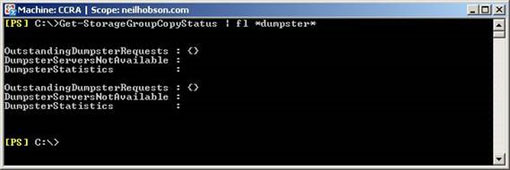
Figure 7: Get-StorageGroupCopyStatus command.
From Figure 7 you can also see that no dumpster statistics are displayed. To test these statistics, you need to use the DumpsterStatistics parameter as shown in the following command:
Get-StorageGroupCopyStatus -DumpsterStatistics | fl * dumpster *The result of this command is shown in Figure 8. The DumpsterStatistics parameter displays the 0 items in the dumpster for the Hub Transport server named SRV1, which indicates 0KB. You can also see the effects that occur when a Hub Transport server in the same Active Directory site as the CCR system cannot communicate. In this case the Hub Transport server called SRV2 is not displayed as it appears in the DumpsterServersNotAvailable list.
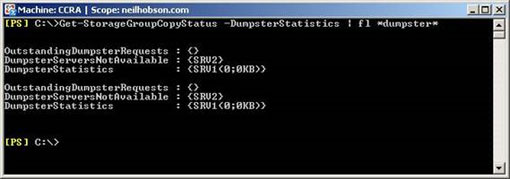
Figure 8: Get-StorageGroupCopyStatus command is used together with DumpsterStatistics.
Next we will check the statistical information on a busy server. In Figure 9 you can see that the information displayed for a single Storage Group has been retrieved and the Transport Dumpster for the Hub Transport SRV1 server now contains 1030 items with a total capacity of 819KB. You will also see the date and time of the oldest mail in the Transport Dumpster queue.

Figure 9: Transport Dumpster information.
To check for more detailed information on Transport Dumpster statistics, we can use the execution management program. On the Hub Transport server, an executable object named MSExchangeTransport Dumpster can be found to contain 5 counters (storage devices that show events or processes that have occurred). You can see these counter in Figure 10.
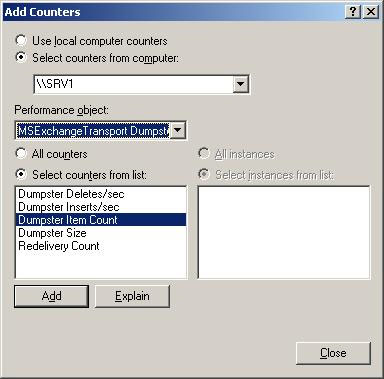
Figure 10: Executing Counter in the Transport Dumpster.
These counter include:
- Dumpster Deletes / sec : This is the number of items deleted per second from the Transport Dumpster queue on this Hub Transport server.
- Dumpster Inserts / sec : Displays the number of items sent to the Transport Dumpster queue on this Hub Transport server in a second.
- Dumpster Item Count : Displays the total number of items currently in the Transport Dumpster queue on a specific Hub Transport server. That's basically the same information that you can get from the DumpsterStatistics parameter of the Get-StorageGroupCopyStatus command that you've done.
- Dumpster Size : Counter Dumpster Size is the total capacity of the transport dumpster items on a specific Hub Transport server. This counter is counted in bytes. On the other hand, this checker displays the same type of information that you can check with the Get-StorageGroupCopyStatus command.
- Redelivery Count : This counter only displays the number of items that are redirected after the Exchange Replication Service has requested to resend the mail.
For example, we conducted a test on the CCR system, we forced a failed conversion situation by turning off the active node while the mail was being processed. When the Microsoft Exchange Replication Service on the CCR node remains requesting to resend the mail from the Hub Transport server, then initiate us to launch the execution control tool on that Hub Transport server and manage the Dumpster Item Count objects. The Dumpster Size and Redelivery Count as you can see in Figure 11. In Figure 11, the entire Transport Dumpster queue has 1540 items returned.
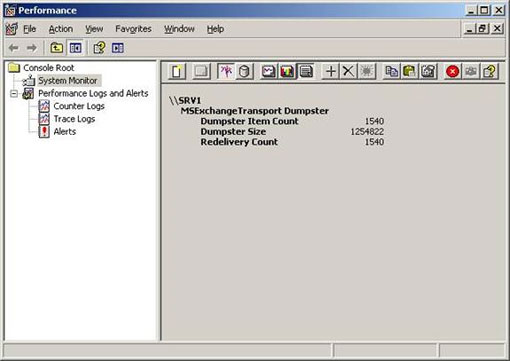
Figure 11: Control the Transport Dumpster's execution counter.
So what really happens in a CCR system when the transition fails? The previously passive node now becomes the active node and requests from the Hub Transport servers in the same Active Directory site that every message from the Transport Dumpster is resent. To see this process work, check the event log on the remaining CCR node for event 2099 using the MSExchangeRepl source. A sample of this event log entry is shown in Figure 12.
You can see in Figure 12 that the CCR system node named CCRB has requested the Hub Transport server SRV1 to resend the mail at specific times. Note that this event will be recorded every 15 minutes if this particular Hub Transport server is unavailable.
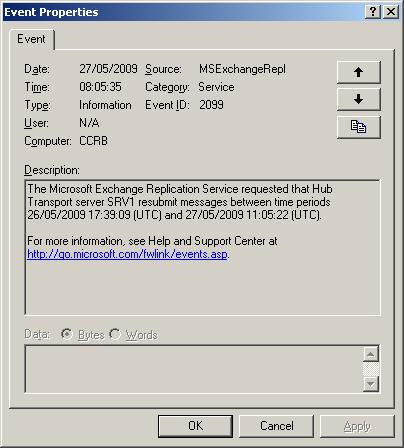
Figure 12: Request to resend in the Transport Dumpster.
Conclude
Now that we have finished the article, we covered two parts of the Transport Dumpster understanding in Exchange Server 2007. This feature in Exchange 2007 can help recover lost data due to a problem with the CCR system. And you only need to use some variables to automate part of its tasks.
5 ★ | 1 Vote
You should read it
- Limit sending and receiving mail in Exchange 2007
- Transfer Exchange 2003 to Exchange 2007 (P.7)
- Transfer MDaemon to Exchange 2007/2003 (P.1)
- Transfer MDaemon to Exchange 2007/2003 (Part 2)
- Transfer MDaemon to Exchange 2007/2003 (P.3)
- Transfer MDaemon to Exchange 2007/2003 (P.5)
- Installing, configuring, and testing Exchange 2007 CCR on Mailbox Server (Part 3)
- Transfer MDaemon to Exchange 2007/2003 (P.4)
May be interested
- Discover EMC in Exchange Server 2010 (Part 1)
 in exchange server 2010, powershell cmdlets has been greatly improved to manage multiple tools, and administrative tasks are made easier on emc.
in exchange server 2010, powershell cmdlets has been greatly improved to manage multiple tools, and administrative tasks are made easier on emc. - Transfer MDaemon to Exchange 2007/2003 (P.5)
 in this section we will perform public folder migration, public folder management of mdaemon and configure the outlook workstation to use exchange server 2007.
in this section we will perform public folder migration, public folder management of mdaemon and configure the outlook workstation to use exchange server 2007. - Discover EMC in Exchange Server 2010 (Part 2)
 in the previous article, we learned some new features in exchange server 2010, including: high availability, archiving, federation and sharing.
in the previous article, we learned some new features in exchange server 2010, including: high availability, archiving, federation and sharing. - Transfer Exchange 2003 to Exchange 2007 (Part 1)
 in this series, we will learn how to migrate data from exchange server 2003 system to exchange server 2007 system.
in this series, we will learn how to migrate data from exchange server 2003 system to exchange server 2007 system. - Transfer MDaemon to Exchange 2007/2003 (P.6)
 in the previous section we performed the public folder migration process and used a base script to configure the current outlook connector user on the new system.
in the previous section we performed the public folder migration process and used a base script to configure the current outlook connector user on the new system. - Public Folder management in Exchange 2007
 exchange server 2007 service pack 1 provides two public folder administration environments, exchange management console and exchange management shell.
exchange server 2007 service pack 1 provides two public folder administration environments, exchange management console and exchange management shell.






 Transport Dumpster in Exchange 2007 (Part 1)
Transport Dumpster in Exchange 2007 (Part 1) Installing, configuring, and testing Exchange 2007 CCR on Mailbox Server (Part 3)
Installing, configuring, and testing Exchange 2007 CCR on Mailbox Server (Part 3) Transfer Exchange 2003 to Exchange 2007 (P.7)
Transfer Exchange 2003 to Exchange 2007 (P.7) Introduction to Exchange 2007's Edge Transport Server (Part 1)
Introduction to Exchange 2007's Edge Transport Server (Part 1) Balancing download of Exchange 2007 SP1 Hub Transport servers with Windows Network Load Balancing (Part 1)
Balancing download of Exchange 2007 SP1 Hub Transport servers with Windows Network Load Balancing (Part 1)